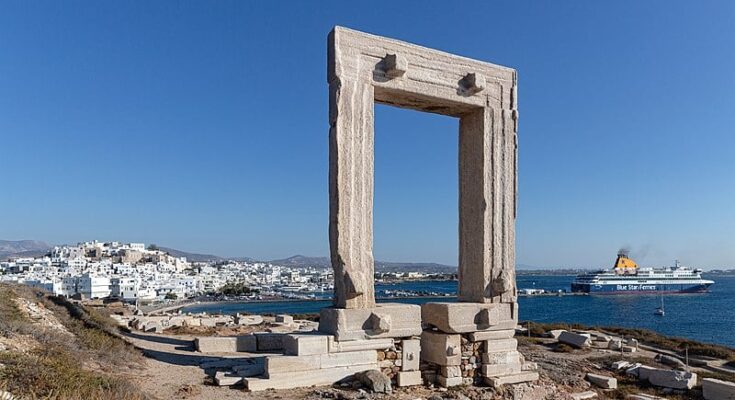The imposing ruins of the Portara, or gate, still stand on the islet of Palatia on Naxos. What remains of a temple dedicated to Apollo, which was built in the 6th to 7th century BC and was never completed, stands behind it today in mute beauty.
According to Greek mythology, the god Theseus left Ariadne, whom he had abducted from Crete earlier after he had killed the Minotaur to live on Naxos.
According to the myth, during their trip from Crete, Theseus and Ariadne made a stop at the island. Theseus saw the Greek god Dionysus in a dream while staying there, and the god told him that he had to leave Naxos without Ariadne since she was meant to stay there and become his wife.
Ariadne indeed stayed on Naxos and married the god Dionysus, and her worship as a goddess flourished for centuries on the island.
The history of the Portara in Naxos
At one point, the tyrant Lygdamis began to build a temple on Naxos’ tiny islet of Palatia. He had grand ideas of creating a temple even larger than that of Zeus in Athens or the temple of Hera on Samos.
After the tyrant’s fall, the temple remained unfinished, leaving only its foundation and part of its gate, or Portara.
The gate was originally constructed of four large pieces of local marble, each weighing approximately twenty tons. The Portara has a height of nearly six meters (sixteen feet) and a width of at least 3.5 meters. After the rise of Christianity, a church was built on the ruins of the temple, but this was later destroyed by the Venetians.
Portara today is connected with the Naxos mainland via a paved footpath. The spot offers one of the most enchanting sunsets in Greece.
Where are the marbles of the Portara?
The marbles once comprising parts of the Portara were known to have been used by the Venetians to construct other buildings, mainly the Castle of Chora in Naxos, which was built in medieval times by the Venetian Marco Sanoudo.
Sanoudo constructed the castle on a hill that rises approximately thirty meters above sea level over the remains of the ancient acropolis, which he considered a suitable place for the establishment of the city of Naxos. The most remarkable feature of his castle is that its wall is made up of the houses of the city itself, which were erected along its perimeter.
Today, the visitor, while taking a stroll through the beautiful alleyways of Naxos, can see gleaming marble stones from the Portara in various places around the city. The unmistakable smooth, glassy stone stands in stark juxtaposition to the darker, rougher stone used for the rest of the walls.
The ancient history of the island of Naxos continues at every step, with stones quarried almost three thousand years ago telling an eternal story of destruction and survival.



